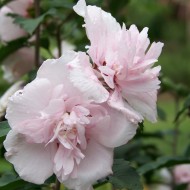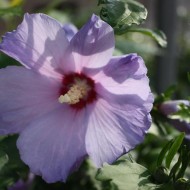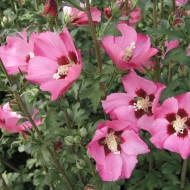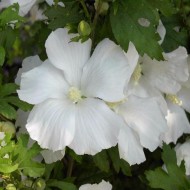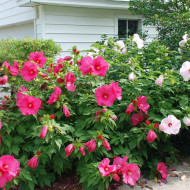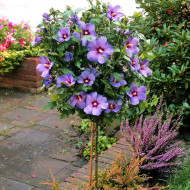How to plant and grow Syrian tree hibiscus in the garden
Content
Description of Syrian hibiscus
The second name of the deciduous culture of the Malvov family is the Syrian rose or Sharon. Hibiscus syriacus is native to the Asian subtropics. The plant is a tree-like shrub about two meters high. Branches are erect, strong, practically not branching. The leaf plates are ovoid, with jagged edges. The flowers are large, simple or double type. The color is characterized by a varied palette, depending on the variety.
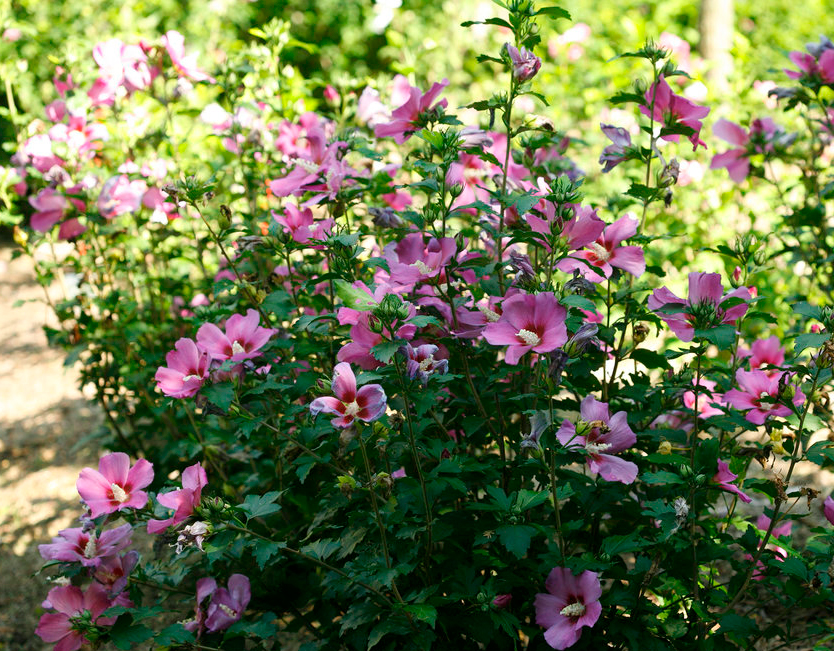
Garden hibiscus is a late crop, in which the first foliage appears only towards the end of spring. Flowering begins in mid-summer, and decorative qualities persist until early October.
Popular varieties with photos
Rose Sharon is one of the few members of the genus Hibiscus that can tolerate sub-zero temperatures. Several decades ago, breeders became interested in this exotic with high frost resistance and bred many varieties for central Europe. Some varieties are especially popular among gardeners in the Moscow region:
- Diana. Shrub two meters high with large flowers of a simple structure. The diameter of the rosette is 10-12 cm. The petals are wavy, of a snow-white uniform color.
- Violet Elar Double. It grows up to 1-1.3 m, and during flowering it is covered with double or semi-double inflorescences. The color is soft lavender, with burgundy strokes closer to the core.
- Pink Chiffon. The variety is 1.5-2 m in size, it is distinguished by large (about 12 cm) dense double rosettes. The petals are creamy pink with carmine touches emanating from the center.
- Duc de Brabant. Tall hibiscus two meters high and 1.5 m wide. The flowers are densely double, almost 15 cm in diameter. The color is lilac-red with a purple tint.
- Red Heart. A tall shrub with large semi-double inflorescences 12-14 cm in size. The petals are snow-white, the core has a burgundy "eye".
- Pink Giant. The variety is about two meters high with simple rosettes 10-12 cm in size. The petals are pale pink with a purple tint, the middle is red-burgundy.
- Carneus Plenus. It grows up to 1.5-2 m and is distinguished by densely doubled delicate inflorescences with a diameter of 10 cm. The color is white-pink with a core of the color of Burgundy wine.
- Carneus plenus
- Duc de brabant
- Red heart
- Pink chiffon
- Violet Elar Double
- Pink giant
- Diana
Video "Planting and caring for Syrian hibiscus"
In this video, experts will tell the secrets of the successful cultivation of horticultural crops.
The subtleties of planting and caring for the Syrian hibiscus
Tropical culture is quite capricious, and therefore, in order to grow a decorative bush on your site, you will have to make a lot of effort.Read about the intricacies of cultivation at home below.
How and when to land
The Syrian rose is very picky about temperature fluctuations. Seedlings can be planted only after the spring frosts have passed and the earth has warmed up to +15 ° C. The place is chosen open, well-lit, not ventilated. The soil should be well-drained, nutritious, rich in humus.
The normal acidity level for hibiscus is neutral or slightly low.
In order for the seedling to start well and quickly adapt, you need to strictly follow the planting rules:
- dig a planting hole twice the size of the root system;
- the bottom is drained with small stones or broken brick;
- then humus is laid, and sand on top;
- partially fill the hole with a soil mixture of earth, peat and sand;
- place a young plant, slightly deepening the root collar;
- fall asleep with the remains of the substrate and loosen well;
- pour a bucket of water under the root;
- fill up the soil, forming a near-trunk circle.
Moisturizing and feeding
A tropical crop requires regular watering for normal growth. In order not to rot the root system, the procedure is carried out only when the earth in the near-trunk circle becomes completely dry.
From June to September, ornamental shrubs are fertilized twice a month with mineral complexes rich in nitrogen and phosphorus. Before winter, potash fertilizers are added to the main composition.
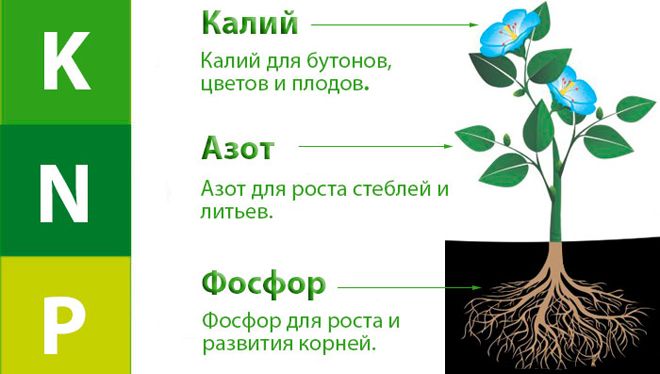
Do I need to trim
The first pruning is done immediately after planting. In a young seedling, branches up to three buds are cut off, leaving the main trunk intact. Further procedures are carried out annually. This is done in early spring, before the juices begin to move, and the second time before wintering, when the bush will shed its foliage. Gardeners carry out two types of pruning:
- Formative. All shoots are cut to two buds, completely removing those that grow at the very bottom. The tip is pinched, leaving three pairs of internodes.
- Sanitary. Remove all dry, damaged and improperly growing branches. Last year's shoots are shortened, leaving 2/3 of the length.
Features of care in the fall
Preparation for winter begins when the plant sheds its leaves. After the green part dies off, it is cut to almost zero, leaving only a few centimeters. The trunk circle is dug up, and then laid with a mulch layer consisting of sawdust or dry grass. Cover with spunbond on top and throw spruce branches.
Reproduction of tree hibiscus
The breeding methods of tropical exotic plants do not differ from ordinary shrubs. Most often, gardeners use three traditional methods. Read more about them below.
Seeds
In order to be in time for planting, preparation should begin in winter. The algorithm for growing from seeds is as follows:
- planting material is soaked in humate for several hours;
- then laid out on cheesecloth, and wrapped on top with polyethylene;
- when the first shoots hatch, they are planted in the substrate to a depth of 5 mm;
- the container is covered with glass;
- when shoots appear, they begin to be regularly ventilated, each time increasing the time in the fresh air;
- in the second decade of May, the grown young growth is transplanted into open ground.
Layers
A method loved by many gardeners for its simplicity. The procedure, which is carried out in the second half of March, is as follows:
- dig a groove two fingers deep near the hibiscus;
- one shoot is taken from the donor bush and laid horizontally in a trench;
- they cover it with earth from above, leaving a few centimeters on the surface;
- in the fall, the grown cuttings are deposited from the mother plant to a permanent place.
Cuttings
Another popular method that allows you to get a strong seedling in a short time. The propagation scheme by cuttings is as follows:
- in spring, a 15-centimeter shoot with 4 buds is cut off from a young branch;
- tear off all the leaves, leaving only a few upper ones;
- planting material is soaked in "Kornevin" for several hours;
- the container for planting is filled with drainage, peat and substrate, and then the cutting is stuck vertically;
- create greenhouse conditions for the offshoot;
- as soon as the root system is formed and gets stronger, the plant is transplanted into open ground.
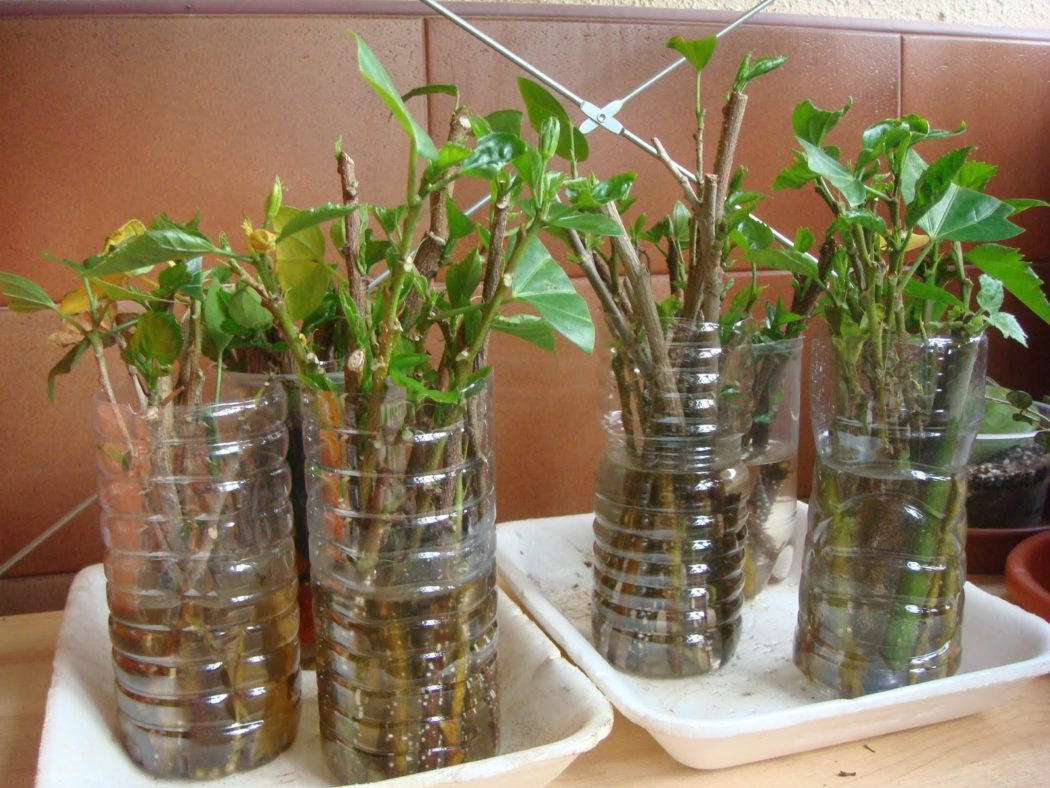
Possible growing problems
A capricious tropical exotic requires more careful care than other garden or indoor plants. We will talk about the problems that gardeners face when cultivating Syrian hibiscus.
Diseases and pests
Due to a lack of nitrogen or iron, Rose of Sharon can get chlorosis. The leaf plates of the lower tier become lighter, acquiring a yellowish tint, and soon crumble. Regular watering with the addition of iron chelate, as well as the introduction of nitrogen-containing dressings, will help to defeat the disease.
Often, the shrub attracts spider mites, whiteflies, aphids, and thrips. When insects appear, the aerial part of the plant is treated with Aktellik or Fitoverm. The procedure is carried out twice with an interval of 1-1.5 weeks.
Why does the flower turn yellow
Hibiscus leaves can turn yellow not only due to chlorosis. The reason may be mechanical damage to the root system or insufficient moisture. If the roots were injured during transplantation, "Kornevin" is added to the water for further irrigation, which stimulates the regeneration of the underground part.

Hibiscus does not bloom
This happens when there is a lack of three microelements in the soil:
- nitrogen;
- phosphorus;
- boron.
In order for the Syrian rose to bloom, it is enough to adjust the feeding scheme by adding the appropriate mineral compositions.
Why do leaves fall
Shedding foliage on the eve of winter is the norm for tropical shrubs. However, sometimes the leaves fly off earlier. There can be two reasons for this phenomenon:
- trauma to the roots;
- incorrect watering.
To eliminate the problem, they set up an irrigation system, and, if necessary, add a solution of "Kornevin".
The use of the Syrian rose in landscape design
An ornamental tropical plant looks good in any garden area. It is planted in groups or as a tapeworm, and is also used for:
- hedges or arches;
- curb landings;
- group compositions;
- design of artificial reservoirs;
- masking design flaws.
- Hedge decoration
- Plot decoration
- Growing on a trunk
- Flower bed
- Stone fence decoration
- Solitary landing
Best of all, hibiscus is adjacent to roses, but it looks no less advantageous next to conifers, lavender, mint or catnip.
Despite some difficulties, the Syrian rose is worth planting in your yard. With proper care, the abundant flowering shrub will decorate the garden from summer to the first frost.

